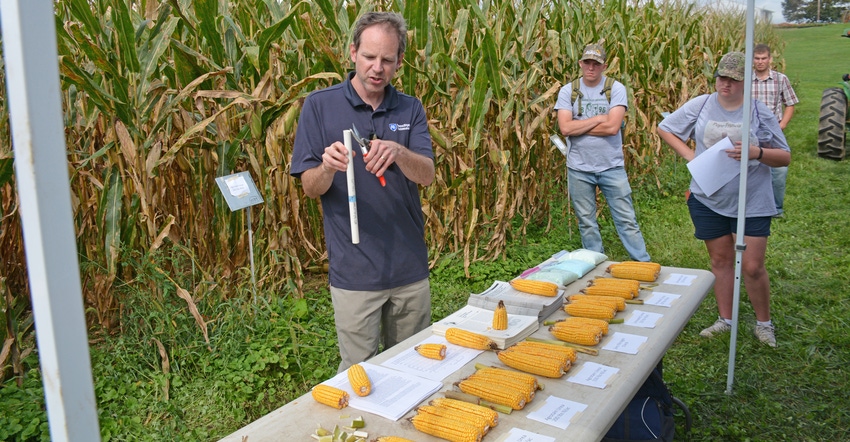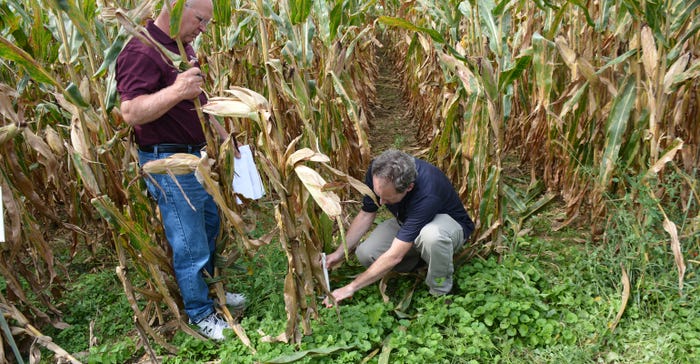
Corn prices won’t always be above $5 per bushel (that’s not even counting local basis, which in the Northeast adds to that price). What goes up must come down.
And when the price does come down, growers always look at ways to cut back to get through the lean times. Fertilizer can be tough to cut back on, especially when the pressure is high to produce more corn on less acres. But do you need all that fertilizer to make your yield goals?
One way to find out is by using a late-season cornstalk nitrate test, which can be done right now, just before harvest.
You have about a month to perform the test — from the quarter milk line to three weeks after black layer, says Charlie White, a Penn State Extension specialist in soil fertility and nutrient management.
Since it was quite wet this year and growers are reporting many late-season stalk diseases, you’ll need to note some caveats when you receive your results. But this late-season test can prove helpful in determining just how much nitrogen your crop is taking and how much you need to provide.
All you need is PVC
While the test is performed by a lab — Penn State can do it for $12 per sample through its Agricultural Analytical Services Laboratory — getting a sample to send out is easy.
Here’s what you need:
14-inch piece of PVC pipe
tape
a knife
At the recent Field Crop Clinic at the Southeast Pennsylvania Research and Extension Center, White demonstrated a simple way to take a sample.
Measure 6 inches on the PVC pipe and place a piece a tape on it. You want to take your sample at least 6 inches above the ground.
Then, place the PVC along the corn stem. Cut the stem at the piece of tape and at the top of the pipe, and you have your 8-inch sample.
Since the lab will need to grind and dry the samples, White suggests cutting them into large chunks, then sending them off to the lab.

Get several representative samples from a field — White recommends 10 — before sending those samples out to the lab. Also, take note of the crop that was grown before corn, whether it was soybeans, alfalfa or corn.
"We have an optimum range that’s 700 to 2,000 parts per million of nitrate in the stalk, and if you're above 2,000 parts per million, it's a very good indicator that the crop didn't need all the nitrogen that you supplied it,” he says. “And so there's an opportunity to reduce a little bit from that.”
But don’t just take one sample. Take at least 10 samples from a field, White says. Also, take note of the crop that was grown before corn, whether it was soybeans, alfalfa or corn.
“Try to build up a history of this. Just like with soil testing, the most valuable thing is to have a history and pattern of trends and see how things look,” he says. “You need to put these values into context with the growing season you had. Did you have a really dry year and you couldn’t achieve the yields you were expecting, and maybe the corn took up a bunch of N and never could utilize it for lack of moisture? Maybe you have a bumper crop because of a great year. Take those into account.”
I got results, now what?
That depends, White says. He recommends taking the test sooner than later for the fact that late-season diseases brought on by rain can obscure results. This year is likely a good example of that as many late-season ailments are affecting fields right now.
Also, consider the amount of phosphorus and potassium you fed your crop, as that can also influence optimum yield.
But if you feel confident in your nitrogen numbers and you don’t think late-season ailments affected your crop much — and you do corn on corn — start planning for next year and play around with different nitrogen rates.
“So maybe the following year if you had high stalk nitrate levels, and you're doing corn on corn, maybe leave some strips where you dial back 30 or 50 pounds and see how it goes. See what it takes to bring you down to the optimum range,” White says.
About the Author(s)
You May Also Like






